Hello all!
My wife and I bought our homestead about a year and 10 months ago - we love it but it is along a major road and we would like more privacy. My focus starting out has been to grow hedgerows for privacy, some food production, and also to support wildlife. I have already shared a lot about my
hugel bed hedgerows along a dirt road I share with my neighbors but I have not shared much about the hedgerow I planted along the front of the house where the major road is.
I'm going to start by showing you what the area looked like before I did any work and my site prep.
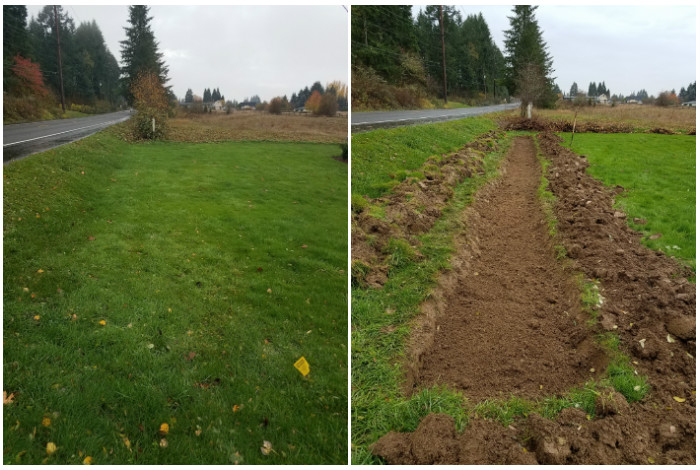
As you can see the site started as just a lawn. I really don't like lawns and a big goal of mine has been to dramatically reduce the size of mine. I also wanted to test out double digging as a method for initial site prep. I first removed the grass and put it on one side of the trench. Next I removed another lay of soil and put it on the other side of the trench. This is a lot of work - especially with heavy clay soil and of course I did all this work in the fall/winter when it was wet...
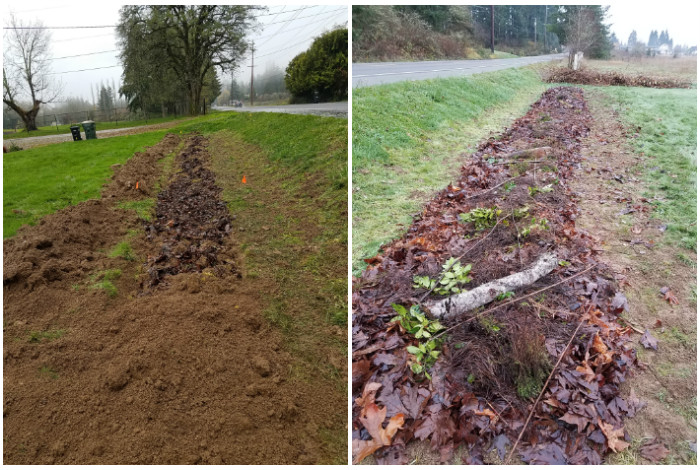
Once the trench was fully dug out I then put the grass back in upside down. Next I added a small amount of
compost that I had made from fall leaves and some other stuff. Then I put the soil back on it all and covered it all with leaves and some wood to hold it all down. I eventually went back through and added wood chips to the top of it all.
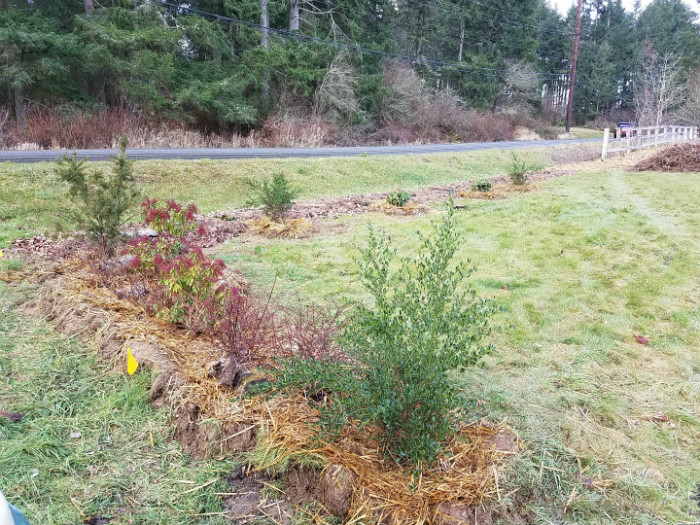
The previous owners had planted several shrubs to try to make the house look nicer before selling it. Well they did not really know what there were doing and planted them in bad areas for the long run. So I dug up the plants and moved them to new homes - a bunch ended up in my new hedgerows. The California lilacs (nitrogen fixer!) have been my favorite and get really nice blue flowers - they are also loved by bumble bees.
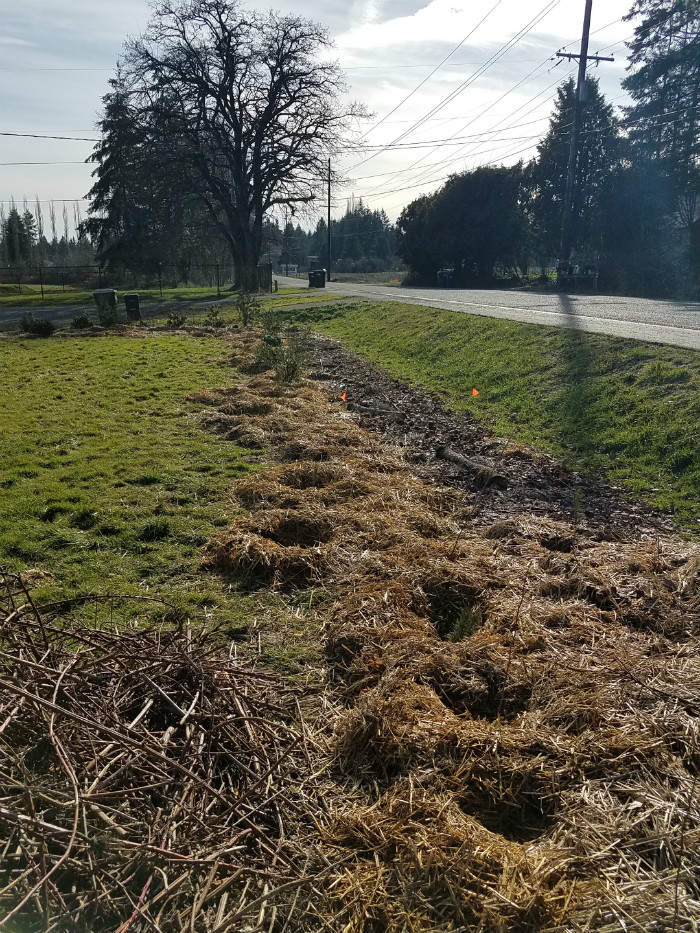
But those plants were no where near enough to make a hedgerow for privacy along a busy road. I also wanted to plant a bunch of native plants to help support local wildlife. So I ordered a ton of native shrubs and some trees and got busy planting! My parents were nice enough to come over and help with them all - my wife was very pregnant at the time with our son and was unable to help.
Since this hedgerow would be visible from our front window I planted a bunch of red flowering currants which are native to my area and get covered in lovely red/pink flowers in early spring. The humming birds also love them! I also planted a bunch of Osoberries (Indian plum), black twinberry, red stem ceanothus (nitrogen fixer - though they have not done great), cascara (small tree), and shore pine. Since this first planting I have also added a dwarf mulberry tree, a small cherry tree/shrub, a couple mock-oranges, a bunch of strawberries for ground cover, and a bunch of native lupines.

As you can see despite this only being its 2nd year the hedgerow has really taken off! The shrubs are quickly filling in and the trees are growing taller every day. At the moment most of what you see are the shrubs but overtime the shore pine will become the dominate component of this hedgerow with cascara filling in. The shrubs will then help create a thick buffer under the taller trees.
I also installed a deer fence around this hedgerow as part of my goal of keeping deer out of my property. Originally I wanted to let the deer in but they did so much damage that I had to fence my property. I will talk more about that in another post but I'm mostly done with the deer fence now and it has been 19 days since a deer has gotten in!

In this picture you can see one of the shore pine on the left side of the image. I like shore pine because they don't get that tall for a conifer - generally only around 60 feet max. This is good because this hedgerow is close to my house so this should minimize any tree damage risk to the house.
The hedgerow gets a lot of sun until the late afternoon so even though it will become very thick it will still behave as if it is a forest edge. This will ensure that the shrubs continue to grow and thrive even when the shore pine become tall and dominate.

I'm keeping the inner part of the front area between my house and hedgerow more open with a few spotlight trees and shrubs. But I'm also going to be planting a ton of native flowers which should be very beautiful once they are established. I want the view from my living room to almost always be one with flowers and birds.
Even though this hedgerow is only in its 2nd year I'm already seeing a lot of birds using it and a lot of bumble bees and other pollinators. I have even found a couple bird nests in the area - I love how quickly life moves into an area if you give it a chance.
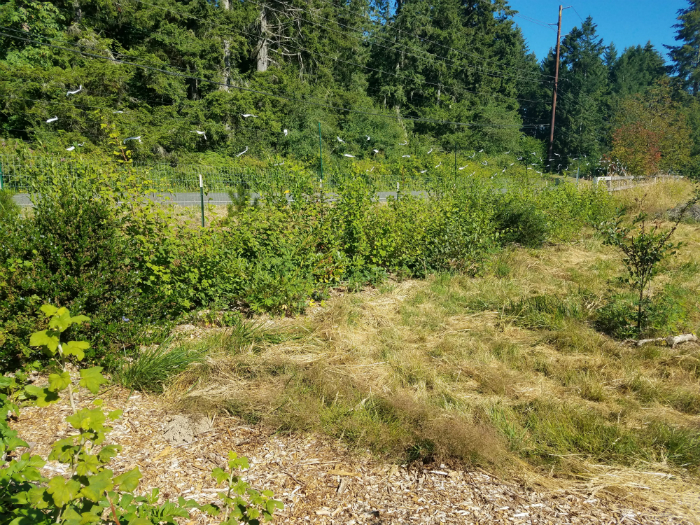
In addition to planting the native flowers I also need to finish mulching the remaining grass between the hedgerow and my house. I want this area to mimic a forest edge and meadow and the grass just does not provide a benefit here. Plus I really don't want to mow it! But I will be including native grasses in with the native flowers - these grasses will be bunch grass types so they won't take over. These types of grasses are very important in a healthy meadow environment and provide habitat for all sorts of critters.
One final note - I always like to add vegetables to areas when I can so at the base of the hedgerow I planted some potatoes. All I did was remove the mulch layer and put them on the soil and then add the mulch back. So far they are doing great and seem to love being in the wood chips!
I hope you all have enjoyed this post - I will add updates overtime as the hedgerow continues to grow and change. At the moment I'm just focusing on finishing mulching but I hope to do some more planting in the fall.












